Complete Guide to Software Development Outsourcing in 2026

Software development outsourcing has emerged as a powerful tool supporting enterprises in gaining global insights to stay competitive. This outline features the tips that will help you break down the process of entrusting your project to an external provider that can create a result-driven program.
Success in outsourcing software development flourishes when you establish a good collaborative environment and select a trustworthy supplier that has knowledge of industry standards, improves decision-making and strengthens project outcomes. Poorly executed contracting out leads to budget overruns, security risks and unsatisfactory results.
In this guide, you will find everything, from pinpointing top-tier outsourced software development to identifying services to solutions that help keep pace with industry frontrunners. We unpack the key insights needed to transform custom software solutions into a powerhouse for expansion. Want to dodge pitfalls and secure a rock-solid provider? Let’s unfold it step by step.
What is software development outsourcing?
The modern business battleground demands agility, expertise, and efficiency — three pillars that distant programming joint effort brings to the table. Instead of burning resources on in-house hiring, entities join forces with elite UK software companies and overseas, unlocking ingenuity without ballooning costs.
The numbers speak volumes: 6 out of 10 organizations have already woven offshoring into their software strategies. By this, they prove that success often lies in knowing when and what to delegate. Recruiting in-house engineers for each project drains both time and resources, often without long-term justification.
Software development projects outsourcing removes this friction, giving the possibility to move swiftly, shrink overhead expenses and unlock the vault of an expansive talent ecosystem. In fields such as AI, blockchain security, and enterprise architecture, external partnerships offer access to world-class knowledge, bypassing the need for continual payroll commitment. That way, you secure the best outcomes by scaling on demand without extra obligations.
The scenario is simple — your project necessitates adjustments. You find people who integrate all the necessary features. As long as the assignments are completed, you explore other possibilities.
Industry watchers anticipate a dynamic surge, with a 6.51% CAGR fueling market growth to a colossal $806.55bn by the end of 2030. It cements outsourcing as a cornerstone of modern software development.
The financial benefits are clear, but the advantages extend beyond budget trimming. Outsourcing software development services also speeds up production cycles — projects that would take months internally may be completed in weeks by experienced offshore or nearshore teams.
Industries leveraging software outsourcing
Third-party providers support the growth of businesses across multiple industries because global sourcing removes the boundaries that cities and even countries put on companies. Now, let’s see which sectors extended force helps most:
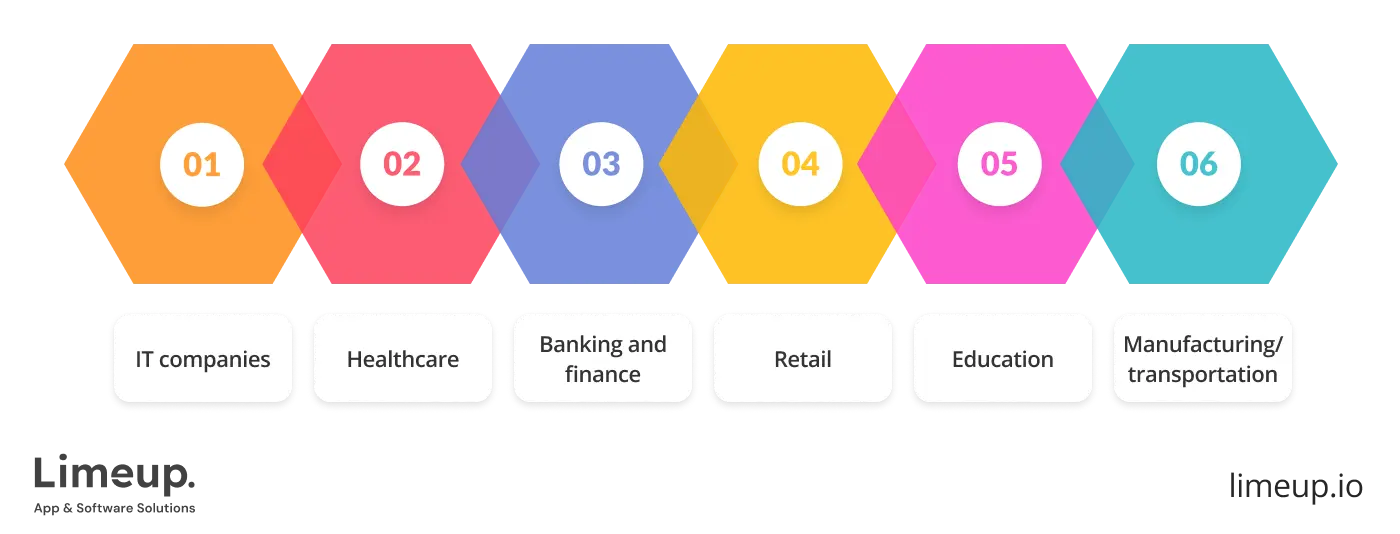
IT companies. When handling operations for millions of users, it is more efficient and cheaper to outsource back-office processes to tested professionals. They have established productive frameworks and address their challenges effectively.
Healthcare. HIPAA and GDPR-aligned systems in telemedicine, patient care, and medical data insights are the crux of the matter for future-ready medical organizations. Phillips Healthcare and Pfizer contract out specialists to obtain critical analytics from leaders of the domain.
Banking and finance. Securing process effectiveness and upholding cyber resilience are critical for financial institutions. Offloading tasks to external developers with a good reputation and reliable work cases allows banks to remain trustworthy and keep a presence in various countries.
Retail. For small and medium-sized eCommerce businesses, outsourced software development services offer a perfect opportunity to manage seasonal demand. External providers prevent downtimes, develop online shops and mobile apps, and integrate CRM and other features. Even established brands like Unilever streamline operations in this manner.
Education. Educational hubs speed up their launches by entrusting the building and maintenance of online resources to subcontractors. They get everything covered, from personalizing a learning path to exclusive recommendations, platform development and global infrastructure,
Manufacturing and transportation. Both spheres share needs for IoT, automation, and predictive analytics backed by AI, and companies like DHL and Siemens receive the latest trends and new features implementation from third-party vendors.
Take a closer look at how task delegation works in your favor. Now, it’s time to dig into the specifics.
Why should you consider outsourcing software development?
Outsourcing isn’t merely about offloading work — it’s about unlocking potential. When done right, it’s a ticket to faster design cycles, access to aces in the field and investment-worthy deliverables that allow you to reinvest in your core functions. Stand-alone advantages form only a small fragment of the extensive range of benefits.

When you hire offshore developers with global access to technical brilliance, they are able to obtain unavailable local skills. Organizations today have the possibility to collaborate with the world’s highest-caliber professionals from any direction.
An outside force empowers you to stay ahead of the game by embracing cutting-edge technology and staying on top of industry trends, making sure you’re always one step ahead in a fast-paced world.
Maintaining exclusively internal personnel for every project follows a risky strategy because. The combination of expenses and additional work often produces overwhelming challenges that are not common in subcontracting.
Businesses achieve economically validated excellence through development that leverages an extensive skill base of qualified professionals. Further in this guide, we’ll explain how to outsource software development without losing this benefit.
When you outsource, you bypass the usual roadblocks that may grind progress to a halt. With specialists from outside who have the dexterity to keep multiple plates spinning at once, your in-house thinkers are able to channel their energy to shape the bigger picture. Gone are the days of being bogged down by internal politics or stretched thin by competing priorities.
By handing over the reins of non-core functions such as platform building, you give your product the breathing room to focus on what really counts: advancing and carving out your position in the market. As we stated above, time is the great leveler, and staying sharp on your growth strategy is what helps you stay ahead of the pack, rather than being stuck in neutral.
Let the outsourced software developers take the heavy lifting off your shoulders. Authorizing global consultants to manage the technical complexities enables your in-house team to zero in on strategy and vision. With the offshore collaborator taking on the construction’s nitty-gritty, your business remains flexible and ready to pivot when necessary. It’s the ideal arrangement where technical mastery meets purposeful direction.
Resource allocation grants firms the ability to expand or streamline their teams on demand, making sure they have the right hands on deck when it matters most. Elastic agreements enable businesses to form partnerships with independent associates without compromising their speed to modify operations.
Such relationships with an outsourced software development team provide businesses with protection so they may easily handle fierce market competition. Organizations use quick workforce modifications to capitalize on new business opportunities and market challenges by eliminating the need for recruitment with lengthy onboarding procedures.
Outsourced software development vs. in-house
Why do more and more businesses turn their eyes to external providers instead of gathering their own teams? The detailed explanation of the gains and drawbacks of both external service delivery and the classic in-house model will give you the answer.

Outsourced software creation
It is typical for businesses to choose IT outsourcing companies due to the price benefits. While reading, you will find out what causes this reduction in price and discover other benefits you tap into when you choose to get software development outsourced:
What problems does it solve:
- Resource-efficient offers. You go straight to the cooperation phase, where, in a week or two after the intro call, you assign tasks and wait for completion. Also, some regions initially have lower rates.
- Qualified personnel availability. Instead of hiring specialists whose help you require for a limited time, you can establish a connection with an external vendor and get what you are looking for.
- Flexibility and scalability. You can easily scale or downsize the task force; it works both ways. Also, outsourcing software developers’ cooperation models enable you to select the approach that best fits your requirements.
What can cause difficulties:
- Possible unforeseen charges. Maintenance, training, time zone difference, and reworks can go with extra charges.
- Less control. Unlike in your office, it is not so easy to take into account each process of outsourcing in software engineering. It happens if the squad is overseas and you have a different time zone.
In-house program development
This is another approach to business-making, which is still relevant and beneficial because, for many reasons you will read about further. However, like anything else, it has particular drawbacks that led to the emergence of other work models:
What problems does it solve:
- Full access and control. When managing your own staff, you have the opportunity to communicate with each employee directly.
- No ownership issues. Everything that is produced by your employees during their work hours belongs to your organization, as stated in the legal agreement you prepared.
- Deep expertise and knowledge of your product. Time-tested permanent staff refine processes, automate routine operations, and distinguish between key requirements and secondary ones easily.
What can cause difficulties:
- Slower onboarding. Unpredictable timeline, with no guarantee that you will find a professional the next day or in a month.
- Administrative responsibilities. Legal, financial, tool management, and backup plan creation are always there.
- Risk of losing key employees. When a core member leaves your project, it takes time to find another.
Align these benefits and issues with your goals. What feels closer to you? Would you rather deal with all administrative questions on your own, or is it better to rely on an outsourcing software development team? For example, suppose you need to launch a digital product rapidly, but you don’t have a workforce. In that case, outsourcing software development companies will provide you with the needed human resources in no time.
It is common for both approaches, permanent hiring and third-party collaboration, to take place at the same time, as seen with companies such as Google, Slack, Samsung, and many others. Usually, it works in a way that core operations remain in the hands of your company’s employees, while maintenance, ERP systems, and APIs are managed by third-party programmers.
To make your decision more informed, we have outlined a brief comparison of two models, allowing you to see the variety of options, as well as their advantages and disadvantages.
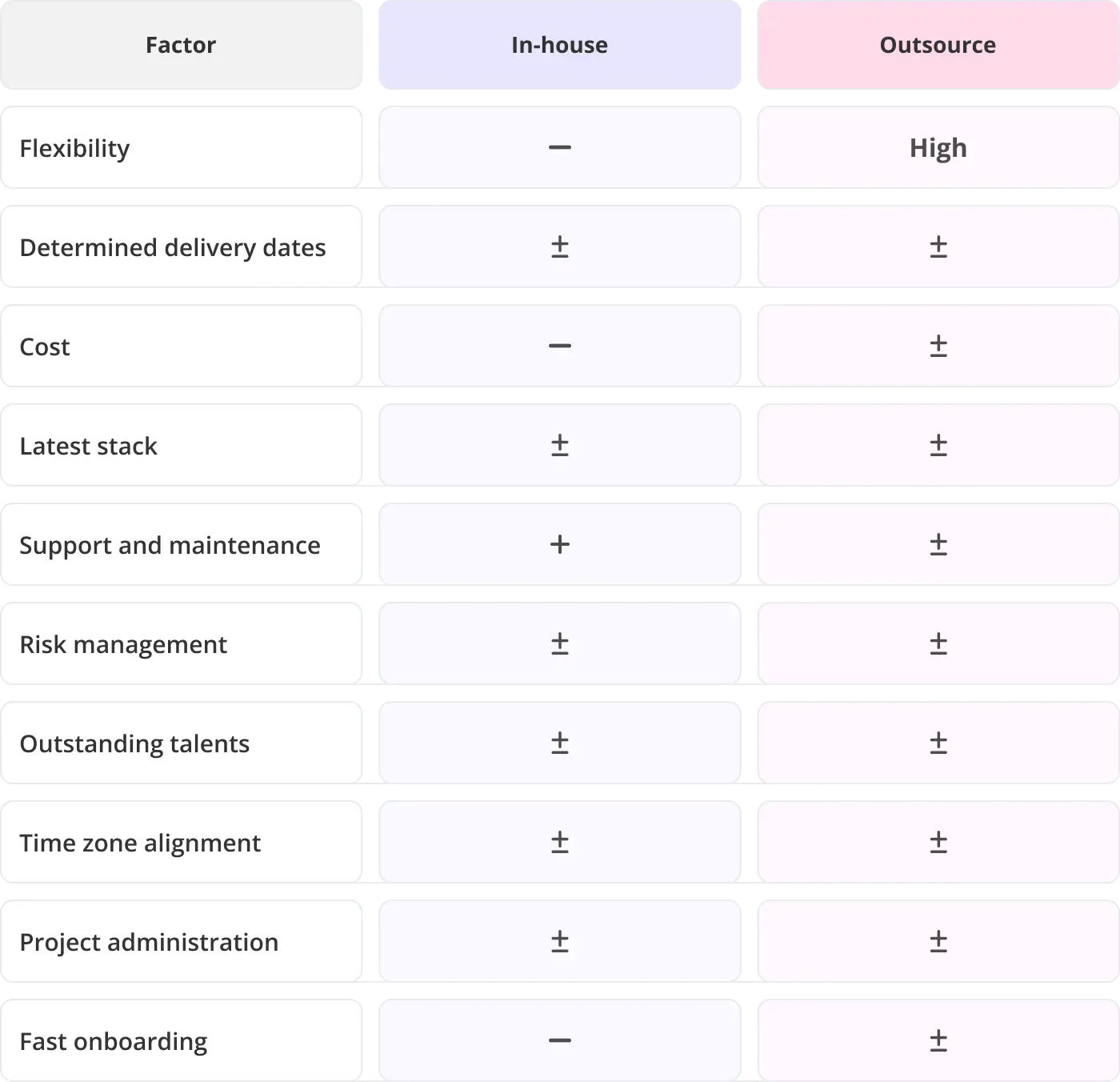
Outsourcing approaches compared: pros & cons
The distinction between various outsourcing firm types is usually in the distance that separates you and your development team. Onshore, or also known as domestic, is the type that operates in your country. Nearshore providers are usually located in neighboring countries. For the USA, Mexico is a supplier of this kind. For Western Europe, it is Eastern Europe. There is also the offshore kind, which involves entrusting your tasks to faraway countries.
As you know, their variations, let’s explore their positive and negative points:
| Approach | Opportunities | Limitations |
| Onshore |
|
|
| Nearshore |
|
|
| Offshore |
|
|
The limitations are not applied to each vendor. Many of them are proficient enough to complete any job related to digital transformation and navigate through all possible options with the best output. In the following segment, we will discuss how to achieve this.
How to successfully outsource software development?
In the previous sections, you came across several potential difficulties connected to outsourcing. In this passage, we are going to explain how to avoid those pitfalls and pave the way for productive alignment:
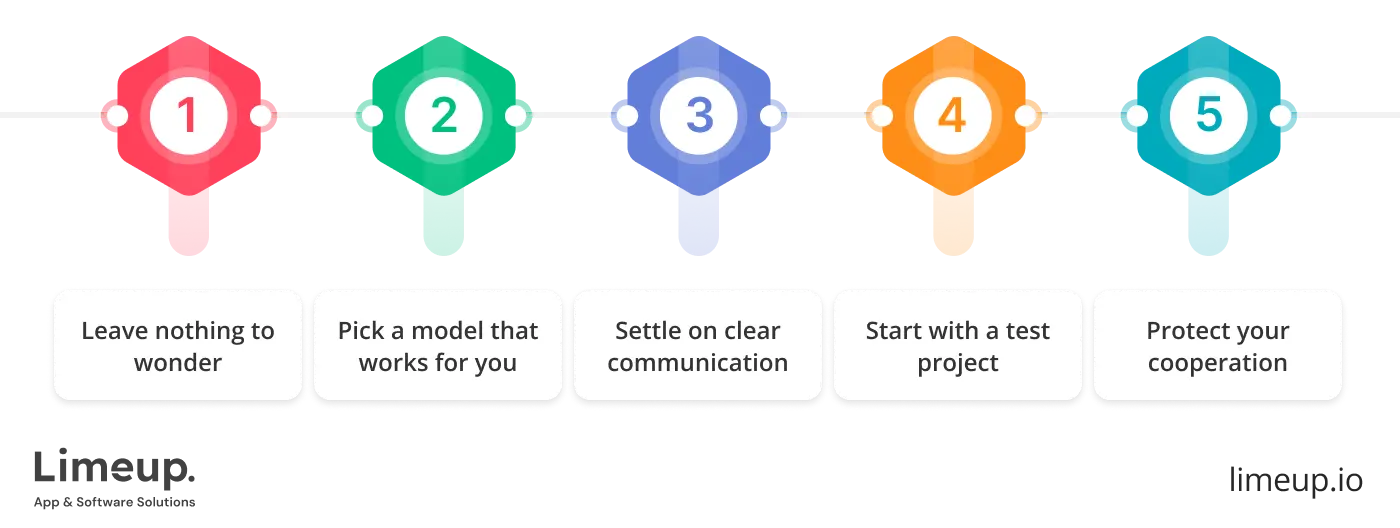
Step 1. Leave nothing to wonder
Outsourcing requires thorough preparation, which you can partially receive by reading this guide. Consider outlining the entire scope of your objectives and goals. A detailed roadmap with performance milestones, necessary features, reporting, meetings, payment approaches, and delivery dates will enable you to be in a strong position.
The same is applied to your awareness of who you choose for software development project outsourcing. There shouldn’t be any ambiguity regarding the company’s capabilities, pricing models, possible hidden fees, standard compliance, and previous collaborations.
Step 2. Pick a model that works for you
Domestic market, specialists from neighboring countries, or experts from faraway corners — pick what brings more benefits. Decide what matters for you best, whether it is market understanding and a shared legal environment, or lower outlays.
| Approach | How it works |
| Staff augmentation | You will be connected with the expert whose skills you need at this time and manage them as part of your squad for a predefined period. |
| Dedicated teams | A vendor takes care of HR processes, while you take care of administration for a long-term period. |
Step 3. Settle on clear communication
Control issues can be majorly solved by a well-established communication plan. You begin by defining the lines you use for regular meetings (if everything happens online), such as Slack or Teams for video and audio connections. Both allow instant messaging so that you can gather everything within one app.
Management tools like Trello, Asana, and Jira make significant differences in task administration. They make it possible for you to see which tasks are planned, in progress, or done, providing access to the latest available information about work status.
Step 4. Start with a test project
Before joining efforts for a durable software engineering outsourcing venture with multiple obligations, evaluate the competencies of a supplier by initiating a small-scale undertaking.
To begin, you can invite one or a few people for temporary work to check how this model functions in your firm. As soon as you ensure that everything goes smoothly with deadlines, assignments, workload, and performance, you extend their roles.
It is a good way to develop a better understanding of future partners when you have enough time for an assessment. When you contact a supplier, you can scale over time, expanding the invited workforce to the target number.
Step 5. Protect your cooperation
When you hire a software developer online, you need to follow a multi-step process that will protect you from various potential threats. First of all, it is essential to have an NDA signed. A non-disclosure agreement doesn’t allow any parties to share information about your business processes, concepts, keeping your existing and future situations confidential.
The other documents, securing your ownership, include:
- Work-for-Hire, creative work belongs to a third party.
- IP Assignment Clause guarantees that designs, code and ideas are your property.
- Statement of work incorporates all the work to be done.
It is worth noting that finding a vendor whom you can trust because of a long list of tracked accomplishments boosts your confidence and allows you to set the right cooperation tone.
How much does custom software development outsourcing cost?
The overall expenditure plans of offshoring services depend on multiple factors that entail provider placement, project complexity, and collaboration methods. We will walk through each point to highlight the financial aspect of cooperation with subcontractors fully.
| Level of software | Prices | Features |
| Basic | $5,000 – $40,000 | Basic functionality, simple UI/UX, user authentication. |
| Middle | $40,000 – $100,000 | Databases, user profiles, API connections, payment options. |
| Enterprise-grade | $100,000 – $500,000 | AI and ML integrations, reporting, real-time analytics. |
| Ongoing support and maintenance | $500 – $5,000 per month | Security patches, feature improvement, bug fixes. |
The figures you can see in the table are average, and the actual cost remains mysterious to most people until direct consultation. Let’s unfold the ranges, exploring everything that stands behind the numbers.
Outsourcing pricing models
Monetary blueprints shape the outsource software development services landscape, as there are no options that perfectly suit each project. Read further to find what describes your cooperation expectations:
- Fixed-price contracts. These are the go-to options for small, straightforward ventures where the scope is clearly defined and deliverables are well understood. Agencies obtain an agreement in advance, enabling them to predict their budget for the period. These contracts remain efficient only when work boundaries remain narrow because objective changes usually generate supplementary expenses.
- Time-and-material agreements. This contract type suits undefined projects or those with expected changes. Such a model provides adaptability since numbers depend on both worker hours and utilized materials. Proper progress management requires attention because it affects how much money is spent.
- Milestone-based tactic. This type’s meaning lies in dividing a venture into several stages. For instance, creating software, engineers deliver each part, UI/UX design, core functionality, testing and more. After completion and approval, their expenses are covered. Ensuring that work is done in accordance with your vision, this model eliminates many risks.
- Hybrid method. Complex, multi-layered projects require combined approaches. It is common that engineers design some features on a pre-agreed fee that is applicable to the fixed-price scheme, while evolving requirements are billed at hourly rates.
A charge scheme is not entirely about the way you are billed. Risk mitigation, flexibility, ROI prioritizing, and resource allocation are directly tied to the way you selected.
Average development rates by region
You’ve probably known about the offshore and onshore pricing difference, and now we’ll look at them in detail. Let’s switch from talking to assessing approximate figures by countries:
| Region | Rates |
| The USA | $60 – $120 |
| Western Europe and the United Kingdom | $50 – $100 |
| Eastern Europe | $40 – $90 |
| Asia | $35 – $90 |
Some latest insights about pricing in different regions:
- Asian rates are the lowest, especially when it comes to junior and middle specialists. Assistance from seniors ranges from the same figures as in Western Europe and the UK.
- Software development companies in the UK offer high-quality deliverables and premium expertise in AI, backed by a deep industry understanding.
- Eastern European firms offer affordable solutions and outsourcing-friendly environments.
The differences between the numbers in the table are also explained by market saturation and the state of the economy in those countries.
Key factors that influence outsourcing costs
Remote task allocation depth extends well beyond service rate calculations. The management of venture projects, as well as the communication function, are critical elements because time zone differences, language variations and expectation misalignment may result in delays and overruns.
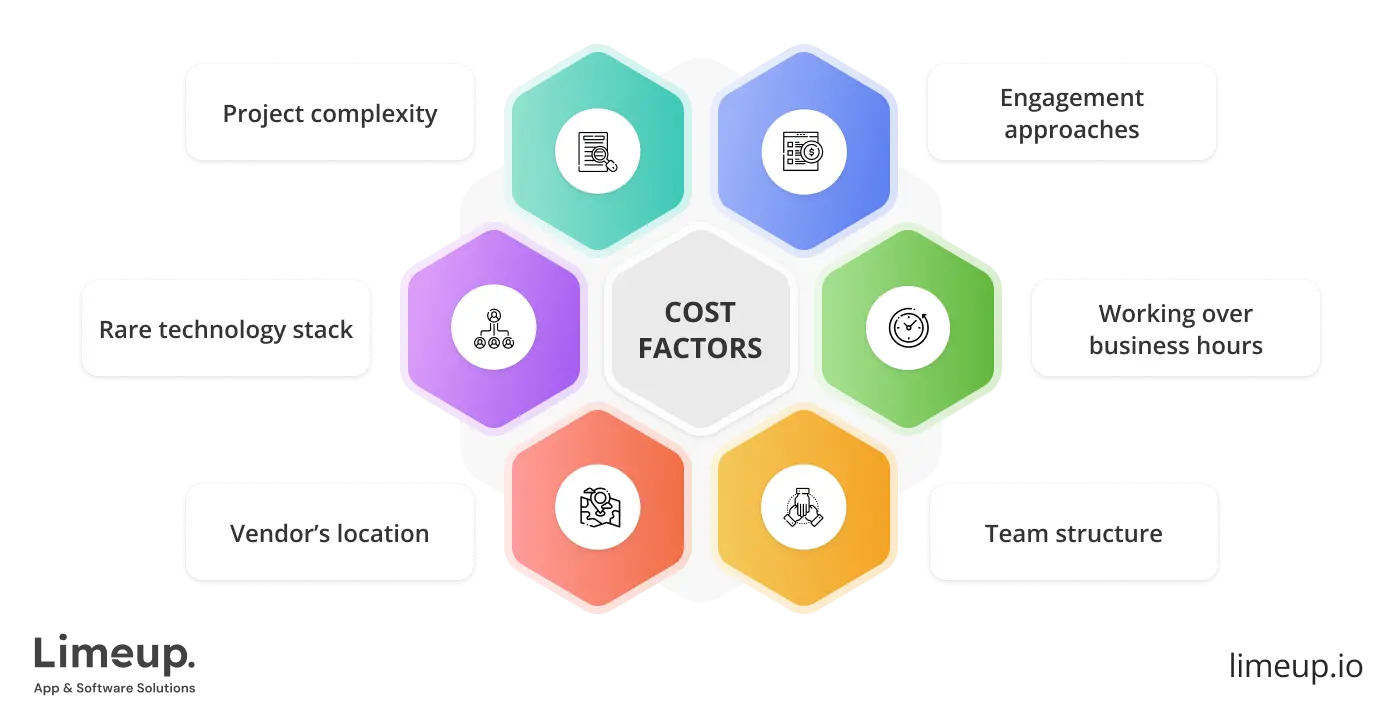
The ongoing production leads to an increase explained by legal commitments related to NDAs. Cutting quality expenditures for economic savings causes similar capital expenses, which combine security protection needs and technical support responsibilities. And this is only a tip of the iceberg, as you also need to consider:
- Rare technology stack. Needing a niche programming language, such as Fortran, COBOL, or Ada, you may experience a shortage while looking for them. Large outsourcing companies can bridge the gap between talent and necessity, but the rates for such professionals tend to be higher.
- Team structure. A single freelancer usually offers reduced spending but does not provide the capabilities for handling large projects effectively. The preliminary expenses for elite cohort selection result in better efficiency and superior work quality deliveries, although the initial outlays remain higher.
- Project complexity. Basic mobile applications are typically developed at more affordable prices than enterprise systems, which integrate AI capabilities and real-time analytics engines. Directly proportional to the intricacy of the project are time demands, resource needs and expert requirements, resulting in higher bills.
- Vendor’s location. The numbers above speak for themselves. A remote program engineering squad in the USA and UK can charge more for outsourcing custom software development than in Asia or Eastern Europe. Price should never be the sole deciding factor; location, skill and proximity to your endeavor play a pivotal role in determining the best fit.
- Engagement approaches. The collaboration model you are going to choose also affects the final figures of the expenditure plan. For example, hourly rates are reasonable when it is obvious when your project will finish. On the contrary, for a long-term partnership, it is wiser to choose dedicated teams where you pay a fixed monthly fee, making it more predictable.
- Working over business hours. Rates in India and Asia may be attractive, but this difference is sometimes swept away by charging for working off-hours in order to achieve round-the-clock progress.
In conclusion, to assemble the pieces of this puzzle in a resource-efficient manner, weigh your options, taking into account the possible duration of the project, functions needed, and desirable results. Nothing influences the budget of an undertaking as much as misalignment between the plan and execution.
Trends in software project outsourcing
Third-party software production is no longer a mere action plan; it has become a driving force behind technological evolution. Agencies worldwide embrace subcontracting associations to accelerate progress, tap into mastery in a field and gain a competitive edge.
The outsourcing landscape never stands still. New methodologies, technologies, and models constantly reshape how firms cooperate with outside cavalry. The latest trends indicate a shift toward smarter, more secure and more integrated outer resource procurement practices.
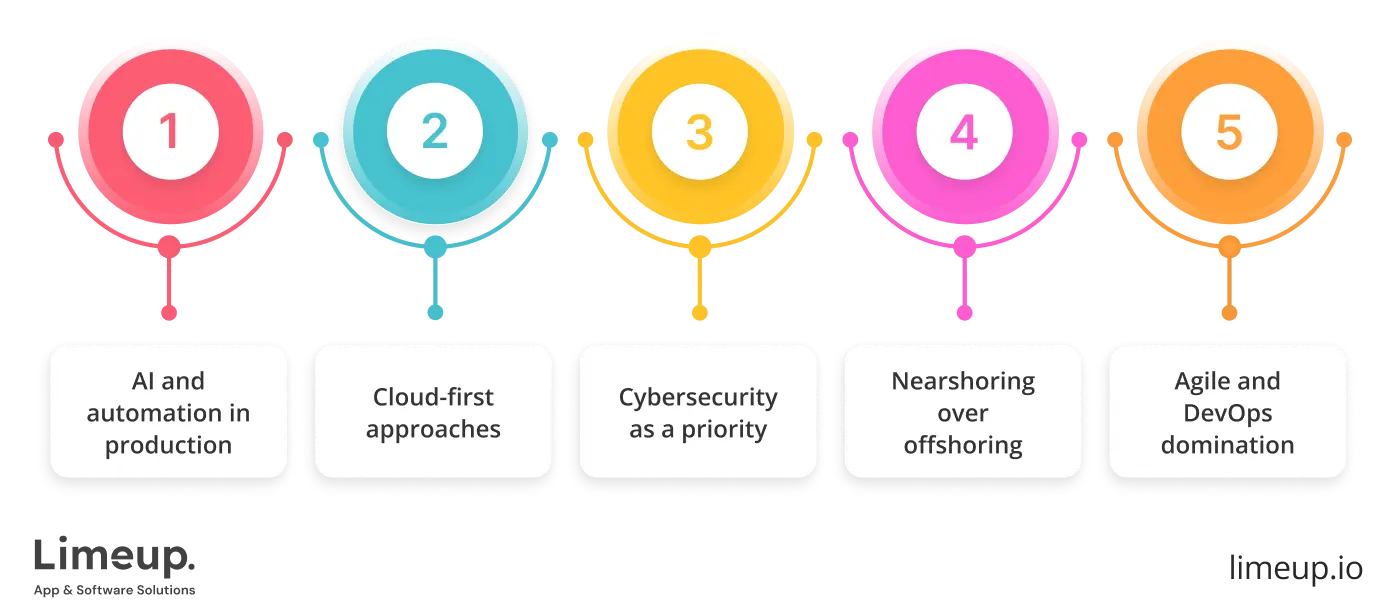
AI and automation in production. Major organizations use AI and machine-based processing as deliberate operations cutters to handle complex business challenges. Automated testing, together with AI code generation and intelligent debugging systems, decreases human involvement to produce better results in terms of efficiency. Affiliates who outsource custom software development create both rapid and economical outcomes.
Cloud-first approaches. The widespread adoption of cloud services amidst enterprises at 94% has led offshore vendors to completely adopt cloud-native architecture. Cloud-based solutions enable in-house and foreign-based authorities to communicate efficiently for unrestricted expansion opportunities.
Choosing the right outsource software development company in the UK can help you leverage cloud-based solutions effectively and achieve long-term growth.
Cybersecurity is a priority. Since cyber threats keep increasing at an alarming rate, firms must enforce more robust security requirements. Obeying GDPR as well as HIPAA requirements has become an absolute requirement for all organizations.
Commercial entities grant their data to overseas joint venture participants through which participants implement advanced encryption, multi-factor authentication and real-time threat detection services.
Nearshoring over offshoring. Proximity matters more than ever. Modern organizations choose nearshoring solutions by expanding their offshore partnerships to countries where the time difference remains nominal. Nearshoring gives organizations superior response times and cultural adaptability and improved contact, making it their preferred offshore choice.
Agile and DevOps domination. The conventional project execution methods produced projects that operated rigidly and slowly. Today, organizations follow Agile and DevOps methodologies, fostering rapid iteration, continuous integration and ongoing delivery. Process cycles have become more fluid, reducing time-to-market for software products.
These subcontracting operations practices have increased dramatically because of several unrefutable market conditions:
- Talent shortages push companies toward external expertise. The lack of skilled workers puts organizations in a position to seek help outside their company boundaries. The market requires more skilled engineers than it is able to currently supply.
- Remote work culture accelerates global collaboration. Adopting a location-independent structure helps companies sidestep the obstacles that used to affect hiring externally, as location has no bearing on the productivity of globally distributed teams.
- Brands request faster innovation cycles. The digital economy dictates that quick adaptation and speed are the essential keys to success. Firms that want to maintain leadership seek off-site vendors that perform quick prototype formation and continuous iteration cycles.
Subconducting strictly follows emerging technologies, with progress in security needs and changing industry requirements. Agencies that detect upcoming shifts and adopt new procedures sustain their market position and claim territory in forthcoming business environments.
The ability to stand still becomes a risk because agile operations combined with strategic partnerships establish themselves as key elements for success in an environment that favors fast adopters.
Why Limeup is the right choice for your outsourced software project
Over the years, Limeup has been supplying businesses across the globe with effective software solutions that enable them to implement adjustments, allowing them to simplify processes for all company departments and deliver intuitive, problem-solving tools to their customers.
Our deliverables adhere to the compliance standards in strictly observed industries, such as healthcare, finance, and education, empowering our clients from over 40 countries, for whom we have completed more than 200 projects, to generate revenue, improve brand awareness, and loyalty.
Connecting with Limeup, you can benefit from:
- Regular reports and transparent communication
- User-first approach. Intuitivity in the core
- Positive track records partnering with world-renowned brands
- Strong expertise in demanding industries. Fully complied, thoroughly tested
- Flexible cooperation models to ensure reasonably priced and productive collaboration
- Result-driven approach. Create software that will work for business performance
Whatever your request is, we will help you unlock your firm’s hidden resources and enhance productivity by embedding all the necessary features, as we did in the case of YugoKraft. Our outsource software developers reduced the error rate by 73% and increased the conversion rate by 54% by implementing real-time customization.
Raccoon.Recovery, a company that focuses on supporting people who recover after illnesses, needed to automate monotonous tasks and enhance patient-tracking activities. The client won a €700,000 growth grant.
Our customer from the USA, Apex Assure, had difficulties with slow and complex policy administration, and wanted to attract more clients to their business. Limeup significantly improved claims processing time by 35% by embedding AI automation tools, and engagement was elevated by 26%. Look at other examples of our work in our case studies.
Whether you are looking for coders to create software from scratch or to modernize your legacy system, Limeup can meet your expectations by accelerating operations, integrating analytics, and AI features.
In summary
Speed, expertise, ROI-driven investments — software subcontracting delivers it all. The current technological landscape expects organizations to secure superior international personnel while simultaneously speeding up software delivery to reach success.
Any company that chooses external allies for specific tasks creates a foundation to assemble modern, scalable technology with advanced AI components and enhanced cybersecurity defenses.
Yet, success doesn’t come from blind delegation. Revenue-generating outcomes through system design alliance requires a pragmatic selection of an understanding outsource software development team that transforms concepts into sound digital products.
The correct plan for delegation fuels business growth because it produces a tactical value that drives commercial improvement beyond financial efficiency.
Why leave your application programming to chance when you may work with industry-leading experts? We bring together high-caliber programmers, designers, and strategists to deliver solutions that propel businesses forward. Don’t settle for the ordinary, and get in touch with Limeup and experience the full benefits of outsourcing.
FAQ about software development outsource
How do I choose the right development partner?
Follow this simple plan to opt for a result-driven software provider:
Step 1. Set criteria for your collaborator
Decide on the preferred collaboration approach, think of the extent of specialists needed, consider the availability of examples of specific projects in their success stories, and don’t forget to outline desirable location and pricing preferences.
Step 2. Evaluate a company’s background and case studies
Visit comment aggregation websites where you can find unbiased opinions of those who have already partnered with the supplier you have in mind. Review its portfolio to assess the outcomes of work and tools used.
Step 3. Get in touch with a potential vendor
Contact the supplier with a selection of questions to see how clear and open the experts are. It is paramount that your communication fully satisfies you and leaves no room for misunderstandings.
How do I ensure quality when working with an external team?
Reaching the best outcomes and securing the maximum effort from your innovation partner’s software development outsourcing services can be done with your involvement in the creation process within the following aspects:
- Agree on regular reports.
Reviewing the process after completing each milestone is more contributory than assessing the finished endeavor. You may find something doesn’t fully align with your idea, and it will be much easier to redo it.
- Sign a reasonable contract.
Your agreement is your main power that secures meeting your objectives. Written descriptive clauses can include performance expectations, deliverables and their functions, and deadlines.
Is outsourcing cheaper than hiring in-house?
The answer is yes, and there are a few reasons why:
- Flexible cooperation
Choosing to entrust your project to an outsourcing provider, you receive the opportunity to extend or downsize the team, depending on the tasks you are engaged in at the moment.
- Pay for the deliverables and milestones
Outsourced custom software development partners take care of everything, so you won’t need to think of building infrastructure, supplying offices with computers, assigning bonuses, and hiring HR. Determined hourly rates, no administrative burden.
- Clear deadlines
Hiring a contractor, you benefit from agreed-upon delivery dates and receive exactly what you need. There won’t be a necessity to consider what work to give an expert when your project is ready, especially if you require assistance from a specialist whose skills are not needed permanently.
How do I protect my intellectual property when outsourcing?
To secure a protected collaboration, you need to sign several documents, including a Work-For-Hire Agreement, an Intellectual Property Assignment Agreement, a Statement of Work, and a Non-Disclosure Agreement.
What are the risks of outsource software engineering?
The risks some businesses face when contracting out are common, but manageable when you know the lay of the land. First, such teaming up may lead to over-reliance on the vendor, when you trust a company too much, including core services. It can be avoided by preparing a backup plan.
Second, many companies struggle to maintain satisfactory project management, especially if they have no prior experience with remote work. That’s where multiple tools that track progress come and save the day.


